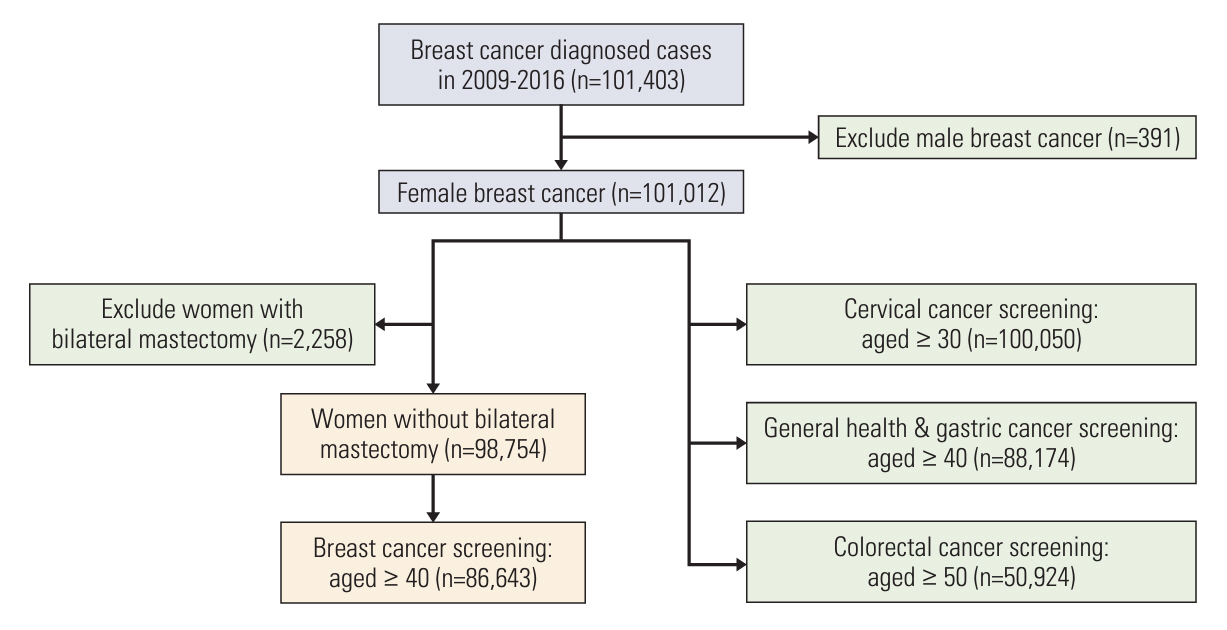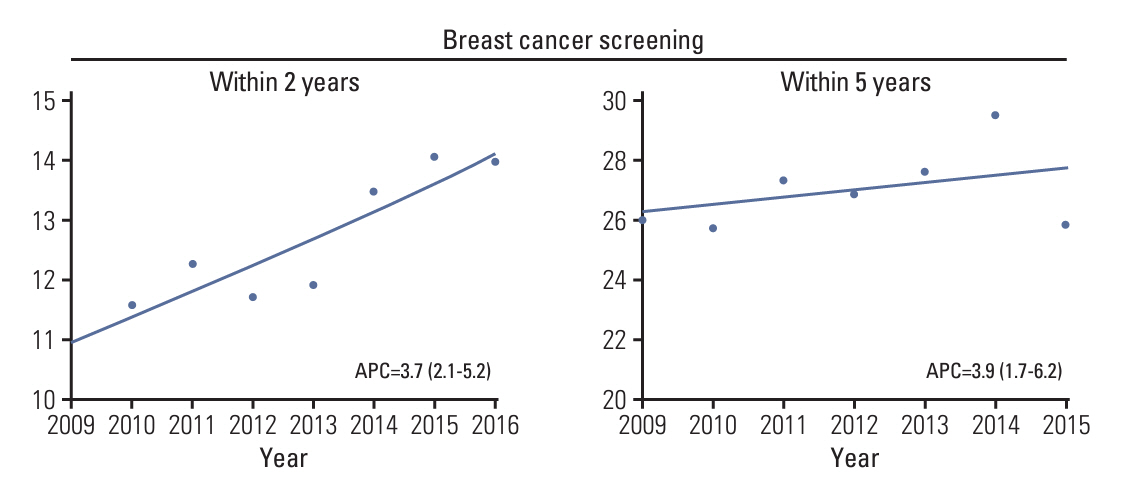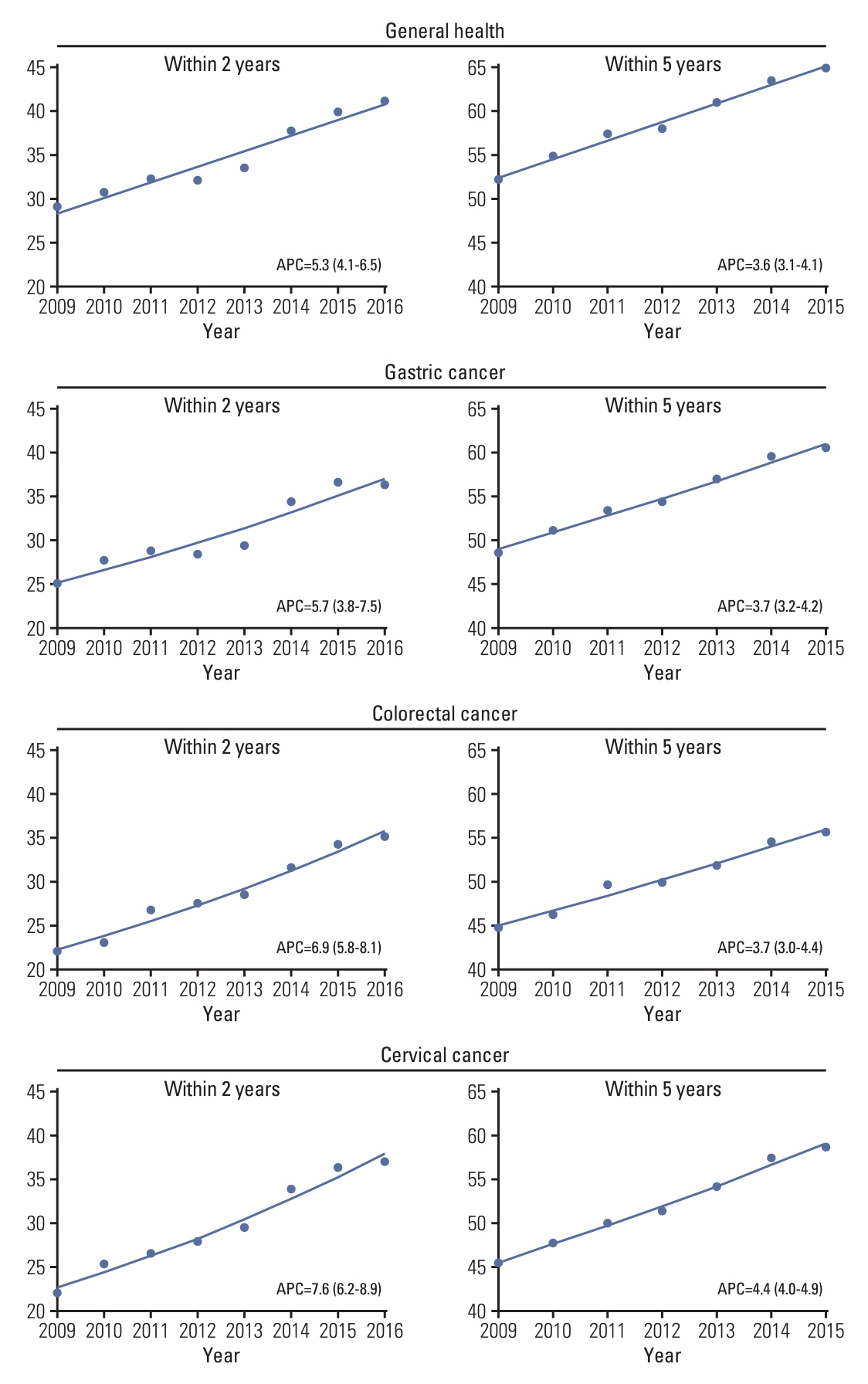Cancer Res Treat.
2024 Apr;56(2):522-530. 10.4143/crt.2023.729.
Temporal Trend in Uptake of the National General Health Checkups and Cancer Screening Program among Korean Women with Breast Cancer
- Affiliations
-
- 1Department of Preventive Medicine, Hanyang University College of Medicine, Seoul, Korea
- 2Institute for Health and Society, Hanyang University, Seoul, Korea
- 3Department of Surgery, Hanyang University College of Medicine, Seoul, Korea
- 4Hanyang Institute of Bioscience and Biotechnology, Hanyang University, Seoul, Korea
- KMID: 2554341
- DOI: http://doi.org/10.4143/crt.2023.729
Abstract
- Purpose
This study assessed the temporal trends of uptake of national general health and cancer screening among women with breast cancer in Korea between 2009 and 2016.
Materials and Methods
We retrospectively analyzed the claims data from the Korean National Health Insurance Service database. Participants included 101,403 breast cancer patients diagnosed between 2009 and 2016. Information on participation in national screening programs, including breast cancer screening, general health, and gastric, colorectal, and cervical cancers, up to 2020 was collected. Screening participation rates within the first 2 and 5 years postdiagnosis were calculated by diagnosis year and fitted with joinpoint regression models to assess temporal trends.
Results
Overall, the participation rate in breast cancer screening within 2 years postdiagnosis increased from 10.9% to 14.0% from 2009-2016, with an annual percentage change (APC) of 3.7% (p < 0.05). The participation rate in breast cancer screening was lower than that in general health checkup and screening for other cancers within 2 and 5 years postdiagnosis. A steady increase in screening trends was also observed for general health, gastric, colorectal, and cervical cancers, with APC of 5.3%, 5.7%, 6.9%, and 7.6% in the 2-year postdiagnosis rate, and APC of 3.6%, 3.7%, 3.7%, and 4.4% in 5-year postdiagnosis rate, respectively. The screening rate was highest among age groups 50-59 and 60-69 in 2009 and significant upward trends were observed in all age groups for general health checkup and gastric, colorectal, and cervical cancer screening.
Conclusion
Among female breast cancer survivors in Korea, the uptake rate of screenings for general health and various cancers, including breast, gastric, colorectal, and cervical cancers, has shown a gradual increase in recent years.
Keyword
Figure
Reference
-
References
1. Siegel RL, Miller KD, Jemal A. Cancer statistics, 2020. CA Cancer J Clin. 2020; 70:7–30.
Article2. Hong S, Won YJ, Park YR, Jung KW, Kong HJ, Lee ES, et al. Cancer statistics in Korea: incidence, mortality, survival, and prevalence in 2017. Cancer Res Treat. 2020; 52:335–50.
Article3. Sung H, Freedman RA, Siegel RL, Hyun N, DeSantis CE, Ruddy KJ, et al. Risks of subsequent primary cancers among breast cancer survivors according to hormone receptor status. Cancer. 2021; 127:3310–24.
Article4. Kang D, Kang M, Hong YS, Park J, Lee J, Seo HJ, et al. Temporal patterns of chronic disease incidence after breast cancer: a nationwide population-based cohort study. Sci Rep. 2022; 12:5489.
Article5. Lee G, Park SM. Health screening for cancer survivors. Korean J Fam Pract. 2022; 12:2–8.
Article6. Runowicz CD, Leach CR, Henry NL, Henry KS, Mackey HT, Cowens-Alvarado RL, et al. American Cancer Society/American Society of Clinical Oncology breast cancer survivorship care guideline. J Clin Oncol. 2016; 34:611–35.
Article7. Yoo KY. Cancer control activities in the Republic of Korea. Jpn J Clin Oncol. 2008; 38:327–33.
Article8. Suh M, Song S, Cho HN, Park B, Jun JK, Choi E, et al. Trends in participation rates for the National Cancer Screening Program in Korea, 2002-2012. Cancer Res Treat. 2017; 49:798–806.
Article9. Hong S, Lee YY, Lee J, Kim Y, Choi KS, Jun JK, et al. Trends in cancer screening rates among Korean men and women: results of the Korean National Cancer Screening Survey, 2004-2018. Cancer Res Treat. 2021; 53:330–8.
Article10. Lee K, Kim H, Lee JH, Jeong H, Shin SA, Han T, et al. Retrospective observation on contribution and limitations of screening for breast cancer with mammography in Korea: detection rate of breast cancer and incidence rate of interval cancer of the breast. BMC Womens Health. 2016; 16:72.
Article11. Clegg LX, Hankey BF, Tiwari R, Feuer EJ, Edwards BK. Estimating average annual percent change in trend analysis. Stat Med. 2009; 28:3670–82.12. Lowry KP, Callaway KA, Lee JM, Zhang F, Ross-Degnan D, Wharam JF, et al. Trends in annual surveillance mammography participation among breast cancer survivors from 2004 to 2016. J Natl Compr Canc Netw. 2022; 20:379–86.
Article13. Lee EA, Shin J, Hwang EJ, Lee JW. Breast and cervical cancer screening behavior in female cancer survivors: the Korea National Health and Nutrition Examination Survey, 2007-2012. Korean J Fam Med. 2017; 38:116–21.
Article14. Cho J, Guallar E, Hsu YJ, Shin DW, Lee WC. A comparison of cancer screening practices in cancer survivors and in the general population: the Korean national health and nutrition examination survey (KNHANES) 2001-2007. Cancer Causes Control. 2010; 21:2203–12.
Article15. Kang SY, Kim YS, Kim Z, Kim HY, Lee SK, Jung KW, et al. Basic findings regarding breast cancer in Korea in 2015: data from a breast cancer registry. J Breast Cancer. 2018; 21:1–10.
Article16. Zeng H, Zheng R, Zhang S, Zou X, Chen W. Female breast cancer statistics of 2010 in China: estimates based on data from 145 population-based cancer registries. J Thorac Dis. 2014; 6:466–70.17. Cancer Stat Facts: female breast cancer [Internet]. Bethesda, MD: National Cancer Institute;c2018. [cited 2023 Sep 10]. Available from: https://seer.cancer.gov/statfacts/html/breast.html.18. Dash C, Lu J, Parikh V, Wathen S, Shah S, Shah Chaudhari R, et al. Disparities in colorectal cancer screening among breast and prostate cancer survivors. Cancer Med. 2021; 10:1448–56.
Article19. MacDonald M, Mirza AS, Mhaskar R, Ewing A, Chen L, Robinson K, et al. Preventative cancer screening rates among uninsured patients in free clinics: a retrospective cohort study of Cancer survivors and non-cancer survivors. Cancer Control. 2022; 29:10732748211072983.
Article20. Millar MM, Edwards SL, Herget KA, Orleans B, Ofori-Atta BS, Kirchhoff AC, et al. Adherence to guideline-recommended cancer screening among Utah cancer survivors. Cancer Med. 2023; 12:3543–54.21. Clarke TC, Soler-Vila H, Fleming LE, Christ SL, Lee DJ, Arheart KL. Trends in adherence to recommended cancer screening: the US population and working cancer survivors. Front Oncol. 2012; 2:190.
Article22. Corkum M, Hayden JA, Kephart G, Urquhart R, Schlievert C, Porter G. Screening for new primary cancers in cancer survivors compared to non-cancer controls: a systematic review and meta-analysis. J Cancer Surviv. 2013; 7:455–63.
Article23. Uhlig A, Mei J, Baik I, Meyer C, Uhlig J. Screening utilization among cancer survivors: a meta-analysis. J Public Health (Oxf). 2018; 40:129–37.
Article24. Khan NF, Carpenter L, Watson E, Rose PW. Cancer screening and preventative care among long-term cancer survivors in the United Kingdom. Br J Cancer. 2010; 102:1085–90.
Article25. Kang HT. Current status of the National Health Screening Programs in South Korea. Korean J Fam Med. 2022; 43:168–73.
Article26. Kim YS, Kang HT, Lee JW. The association between cancer screening and cancer history among Korean adults: the 2010-2012 Korea National Health and Nutrition Examination Survey. Korean J Fam Med. 2019; 40:307–13.
Article27. Hahm MI, Chen HF, Miller T, O’Neill L, Lee HY. Why do some people choose opportunistic rather than organized cancer screening? The Korean National Health and Nutrition Examination Survey (KNHANES) 2010-2012. Cancer Res Treat. 2017; 49:727–38.
Article28. Yang MS, Park M, Back JH, Lee GH, Shin JH, Kim K, et al. Validation of cancer diagnosis based on the National Health Insurance Service Database versus the National Cancer Registry Database in Korea. Cancer Res Treat. 2022; 54:352–61.
Article29. Korea Central Cancer Registry; National Cancer Center. Annual report of cancer statistics in Korea in 2017. Sejong: Ministry of Health and Welfare;2019.
- Full Text Links
- Actions
-
Cited
- CITED
-
- Close
- Share
- Similar articles
-
- Trends of Mammography Use in a National Breast Cancer Screening Program, 2004-2008
- Trends in breast cancer screening rates among Korean women: results from the Korean National Cancer Screening Survey, 2005-2020
- Breast Cancer Screening in Korean Women: Report of the National Cancer Screening Program in 2008
- Early screening for breast cancer
- The Development and Effect of Navigator Education Program for Cancer Screening on Women in the Community




